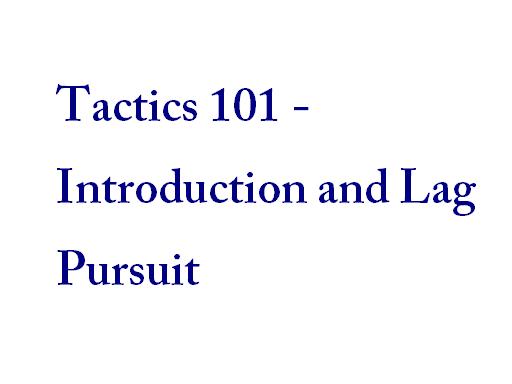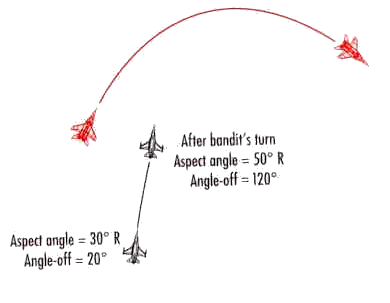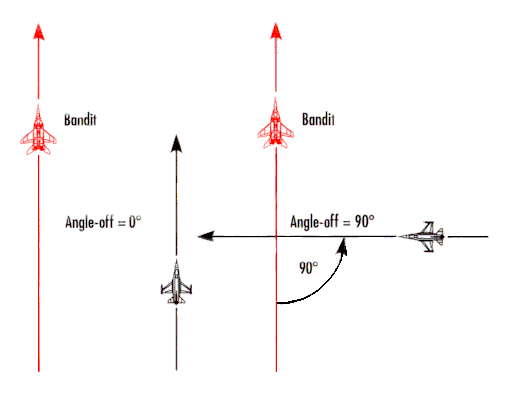by Ed “Skater” Lynch
For those of you that are “old salts” when it comes to flight sims, and for those of you that are new to flight sims, this article should be of some value to you. This is largely a reprint from the manual of one of the best combat flight sims ever released. Spectrum Holobyte’s Falcon 3.0 was indeed the father of all modern, “realistic” combat flight sims. The F3 manual was one hell of a paper weight. Weighing in at something like seven pounds, the F3 manual was jam packed with information on flying the sim, and the usage of tactics, and the deployment of weapons and the employment of the aircraft. Here is a little jewel from the tactics section. Enjoy!
Credit goes to Microprose / Hasbro Interactive, Spectrum Holobyte, and the Falcon 3.0 team.
Introduction to Defensive BFM
The stakes are high when you find yourself on the defensive. Defensive BFM is characterized by difficult, high-G combat, flown while you look out the back of the jet. Since most fighter pilots don’t do their best creative thinking twisted around in the cockpit under high G’s, it is best to have a game plan in mind before finding a bandit at your 6 o’clock. We mentioned in earlier that offensive BFM is not a set of specific moves but rather a series of fluid maneuvers. The same is true when you start with a bandit behind you. There are no magic moves that will move a bandit from your 6 o’clock to your 12 o’clock. In fact, if you fly perfect defensive BFM and the bandit flies perfect offensive BFM, you will get shot down. This statement speaks volumes about defensive BFM.
Defensive BFM is very simple: create BFM problems for the bandit, and when he BFM’s, try to counter his BFM to buy time and survive a little longer. By forcing the bandit to BFM, you may force him to make a BFM error that you can capitalize on. If he doesn’t make a mistake, he will drive into gun parameters. When this happens, you must be ready to defeat the gunshot.
Detecting the Attack
Before you can defend against an attack, you must detect that you are under attack. Most air-to-air kills are against targets that have no idea that they are about to be stuck. There are three primary methods used to detect an attack:
Radar
Your air-to-air radar is the best way to detect an attack because it can look out past 40 nm. All airborne intercept (Al) radars are limited in azimuth and elevation coverage, so radar will not always warn you that bandits are in your area.
Threat Warning System (TWS)
Your threat warning system can detect if any radars are looking at your jet. Again, TWS threat reactions will be covered during the discussion of the engaged two-ship element in the next book.
Visual
No matter how else you detect an attacking bandit, eventually you will have to get a tally to fight him effectively. This chapter will discuss what to do when you see an attacking bandit.
Defending Against a Missile
Whether you see an attacking bandit or not, you must adhere to a fundamental rule of air combat: “Fight the most immediate threat.” You will face a lot of confusing situations as a fighter pilot. To increase your chances of survival, fight the threat that is in the best position to kill you. For example, take a MiG-29 at 6 o’clock that has fired an AA-11 Archer IR missile at you. When that missile leaves the rail and starts guiding on you, the MiG is no longer the biggest threat to your jet. The missile becomes the primary threat, so you must fight the missile.
Here’s another fighter pilot axiom to keep in mind: “Fight missiles with aspect’ When a missile is fired at your jet in the aft quadrant, the best way to defeat it is with a maximum rate turn to put the missile on the beam (along your 3/9 line). You will give a missile the most guidance problems if you put the missile at your 3 or 9 o’clock position. In this position, you will be at 90′ of aspect with respect to the missile, and it will have the worst possible line-of-sight rate problem to solve. Missiles fly lead pursuit courses to the target in order to achieve maximum range. If you hold the missile somewhere on your 3/9 line, you will make the missile pull the maximum amount of lead. You will also be moving across the missile field-of-view at the fastest rate. This image shows this position.
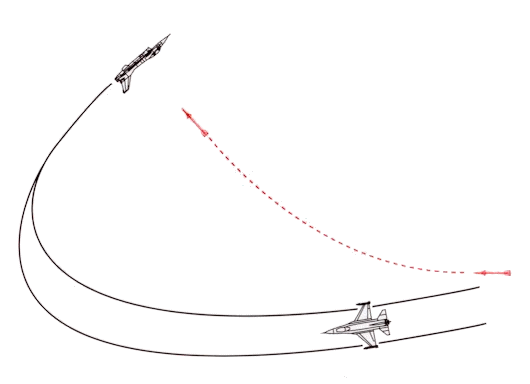
Earlier, we discussed max G turns at corner velocity. It is critical that you generate your best turn rate to drive the missile to the beam quickly. Don’t think in terms of trying to force the missile to overshoot with a tight turn radius. Missiles are designed to explode as they overshoot you. If they fly past you inside the lethal radius of the warhead, you will be turned into a cloud of body parts. Also, while making a defensive turn to put the missile on the beam, always remember to dispense chaff and flares.
Creating BFM Problems for the Bandit
A bandit shows up at your 6 o’clock. What do you do?
If he fires a missile, fight the missile! But before a missile is fired, you must turn and create BFM problems for the bandit. The defensive turn should be the quickest, tightest turn you can make. There are obvious BFM reasons for doing a high-G turn, but there are psychological reasons as well. An 8 G turn into the bandit will make a clear statement of your intent to remain alive and fight this guy with everything you’ve got. An 8 G turn says to the bandit, “It is me against you for all the wine and women in world.” A 4 to 5 G turn says that you are Little Bo Peep and have somehow managed to take off in a fighter. You will invite slaughter (and deserve it) with a weak turn.
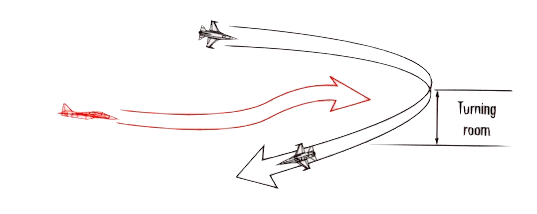
We’ve already mentioned that in order to get the quickest, tightest turn, you must be at corner velocity. As you start a defensive turn into the bandit, you should place your lift vector directly on him. This will give the bandit the most angle-off and aspect problems to solve. You will also deny him turning room by keeping your lift vector directly on his jet. It is easy to see why turning with your lift vector off of the bandit will give him turning room. In the above image, you can see a defending F-16 placing his lift vector below the horizon while doing a defensive turn. The attacking MiG-29 stays level and gains turning room above the defender by just driving in level.
Bandit Outside Your Turn Circle
So you have rolled your jet to place your lift vector right on the bandit and executed your best high-G turn at corner velocity. What next?
Now you must determine if your defensive turn is working. If the bandit is being forced forward from 6 o’clock toward your 3 or 9 o’clock position, then the turn is working. A bandit that starts outside your turn circle will be forced in front of your 3/9 line if you perform the defensive turn correctly. The next image shows a MiG-29 attacking an F-16. The F-16 pilot turns with his lift vector on the bandit at corner velocity and forces the bandit in front of his 3/9 line.
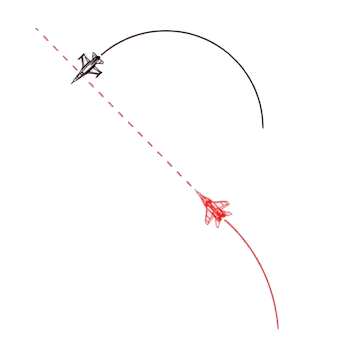
Your turn is working if you push a bandit forward towards your nose. Keep in mind that he can still shoot you! If the bandit has his nose in lead as you drive him forward with your defensive turn, be ready to defend against a gunshot. Remember, in order for him to take a gunshot, he needs to meet three conditions: he must be in range, he must be in plane, and he must have his nose in lead pursuit. If the bandit’s nose is in lead pursuit, watch out! Even though he will overshoot, the bandit will probably attempt a gun shot at the pass. To defend against this type of gunshot, all you have to do is break suddenly out of plane. Because of the high line-of-sight rates involved, the bandit will not be able to correct in time and will overshoot. A bandit that starts outside your turn circle and drives in with his nose in lead for a gunshot will overshoot. Overshoots are discussed in more detail below.
Bandit Inside Your Turn Circle
What if the bandit starts at 1 nm? Your reaction should be the same. Put your best defensive turn on the bandit and see what he does. When a bandit starts close to your turn circle, he is a serious threat, and your best defensive turn may not force him forward. The bandit has one good option if he is committed to staying around and killing you: he has to fly lag pursuit to get to your turn circle entry window. When a bandit starts inside your turn circle and drives to lag, you are in for a long day. The best course of action is to continue your high-G turn and try to stick his nose in lag. There are some schools of thought that say you should unload the jet (release the G) and extend for energy. The problem with an extension is that it is very hard to judge how long to keep the jet unloaded and driving straight. When you unload and accelerate, the bandit will move quickly to deep 6 o’clock, and you will probably attract an AA- 11 shot. The best course of action against a lagging bandit is to continue turning and see if the bandit has a sufficient turn rate to get his nose around on you. If he does, get ready for gun defense. Our next image shows a MiG-29 flying a good lag entry on an F-16.

The bandit may not fly perfect BFM. What if he climbs above you?
If the bandit pulls into the vertical for turning room, keep the hard turn coming with your lift vector directly on the him. As you pull up into the bandit, watch him. If he immediately pulls down to a lag position as you pull up into him, he knows what he is doing and will quickly dose the range for a gunshot. If he keeps his nose high, you will end up in a neutral position on the bandit because you are slower and have a smaller turn radius. Since you have just started your turn, you should still have enough energy and turn rate ability to get around the corner and pass the bandit at high angles. This image shows this type of fight.

In this type of fight, you will end up in a scissors. Scissors occur when two fighters are in a line-abreast, neutral position. They both pull for each other’s 6 o’clock position and, as they pass, they roll back into each other and pull. The scissors is usually won by the fighter that can slow his forward velocity, in relation to the bandit, the quickest. Our next image shows a scissors.
Lead pursuit is another attack pursuit course that the bandit may take. If a bandit starts at 1 nm back and flies a lead pursuit course, he will probably overshoot. Remember the 2 nm setup already discussed? The same result will occur at 1 nm. In order to force the bandit to overshoot, however, you must be executing your best turn. The bandit will not overshoot if you are 50 or more knots slower or faster than corner velocity, or if you are not pulling enough G.

The last option the bandit has is a pure pursuit attack. If you see a bandit pointing at you and a missile is not coming off of his jet, you are in for a treat. A guy that points at you for more than a few seconds is clueless. This type of maneuvering is called HUD BFM. HUD BFM almost always results in a gross overshoot and a lead change-in other words, the bandit will end up in front.
Overshoots
There are two type of overshoots: the flight path overshoot and the 3/9 line overshoot. A 3/9 line overshoot is always tactically significant, while a flight path overshoot may not be. The next image shows a 3/9 line overshoot along with two flight path overshoots. Aircraft A slightly overshoots the F- 16’s flight path. This is not tactically significant. Aircraft B, on the other hand, overshoots the F-16’s flight path far enough that he may end up line-abreast or out in front if the F- 16 reverses his turn. Aircraft C is obviously in big trouble because he has blundered past the F- 16’s 3/9 line. All overshoots are not created equal.
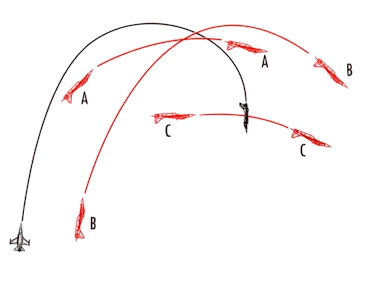
When you predict that a bandit may overshoot, note the range, angle-off, and the line-of-sight rate of the bandit. His position, in relation to you, will dictate how you will reverse. As a rule of thumb, the greater the range when he overshoots and the slower the line-of-sight rate, the less chance you have of forcing him out in front of your 3/9 line with a reversal.
When a bandit overshoots, there are basically two ways to reverse your turn to take advantage of it. If you see the bandit is going to overshoot with a high line-of-sight rate, you should perform an unloaded reversal. To do an unloaded reversal, simply release the G, roll the aircraft to position your lift vector directly on the bandit, and then pull maximum G directly at him. You should only use this reversal method when you are sure that the bandit will overshoot. This type of reversal does not “force” the bandit out in front of you; it just gets your nose on the bandit quickly when he does overshoot.
The other type of reversal should be used with caution. It is called a loaded reversal. To execute a loaded reversal, keep the Gs on the jet as you roll and pull toward the bandit. This type of reversal is used to “force” a bandit that is about to overshoot into an overshoot. This type of situation is shown here.
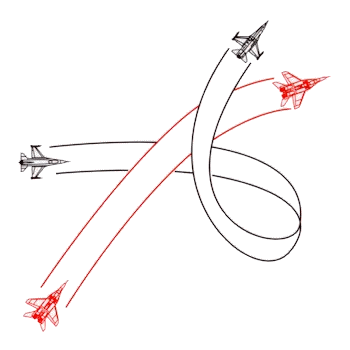
The problem with a loaded reversal is that, if you execute it and the bandit doesn’t overshoot, you will have a bad guy in your chili at close range, and you won’t have the air-speed to maneuver. A loaded reversal is used to stop your aircraft in the sky, and if doesn’t work, you’re in trouble. For this reason, let’s go over a few overshoot rules of thumb.
When in doubt about a bandit’s overshoot, don’t reverse your turn. It is best to reverse when a bandit is overshooting your flight path inside 2,000 feet with a high line-of-sight rate. Outside 3,000 feet, it is best not to reverse your turn. The bandit has too much room to correct his overshoot and maintain a 3/9 advantage on you.
Guns Defense
You have flown perfect defensive BFM, but the bandit has flown perfect offensive BFM and is closing for a gunshot. What should you do?
Snapshots and Tracking Shots
There are basically two types of gun shots: the high line-of-sight snapshot and the stabilized tracking gun shot. This chapter has already briefly explained how to defend -against a snapshot. When a bandit is closing with a high line-of-sight rate on your jet with his nose in lead, think “snap-shot’ ” A snapshot is usually not the result of perfectly flown BFM, but it can still kill you. To defend against a snapshot, you should break out of plane. The only tough part is judging when to make your move. It is better to make it too soon rather than too late. If you go early, the bandit can correct, but when he does, you can jink out of plane again. If you jink late, you may end up having a valuable appendage carved off by the bandit’s gun.
How about tracking gun shots? These are harder to defend against because the bandit is not passing his gun through you quickly, as he does in a snapshot. In a tracking gunshot, the bandit is in a stable position behind you and will take multiple shots. For this reason, you will have to make multiple out-of-plane jinks to keep from getting shot. The key to guns defense is to make sudden jinks at least 70° out of plane with the attacker. Keep a tally on the bandit, and before he gets established in this new plane of motion, jink again. This type of defense is a random guns jink.
The Snake
A popular guns jink, currently in vogue in the F-16 community, is the “snake.” Here’s how you do it: when you see the bandit pulling his nose into lead, you unload rapidly, roll 180°, and reverse your direction of turn. Hold this course and make the bandit pull his nose back into lead. If the bandit reduces power to stay behind you, he may end up getting stuck in lag. If his nose is stuck in lag, keep turning with your lift vector above the horizon.
If the bandit has the energy to get his nose back into lead, unload again and roll 180° to reverse your turn again. This time, reduce power to bait him into an overshoot. As the bandit repositions to lead pursuit, unload and roll 180′ again and reduce power further. If you have lived this long, you should be jamming the bandit and forcing an overshoot. Anytime you see that the bandit is going to over-shoot, get back into full burner, set your wings level with the horizon and pull max G. This will help him fly out in front of your 3/9 line.
This maneuver is not a magic move. If the bandit is highly skilled, he will probably gun you, snake or no snake. It is worth a try, however, because against a plumber, it will work almost every time. If you’re lucky, you might get a chance to see his best guns defense.
Part One: The Geometry of Air Combat
Part Two: Introduction to Offensive BFM


